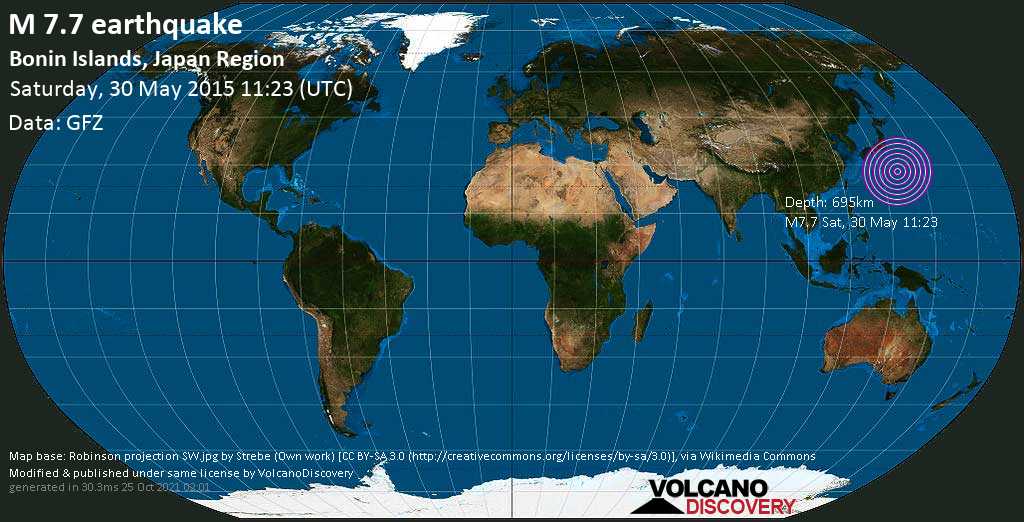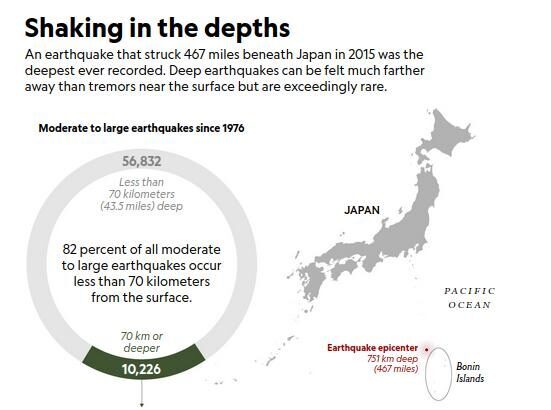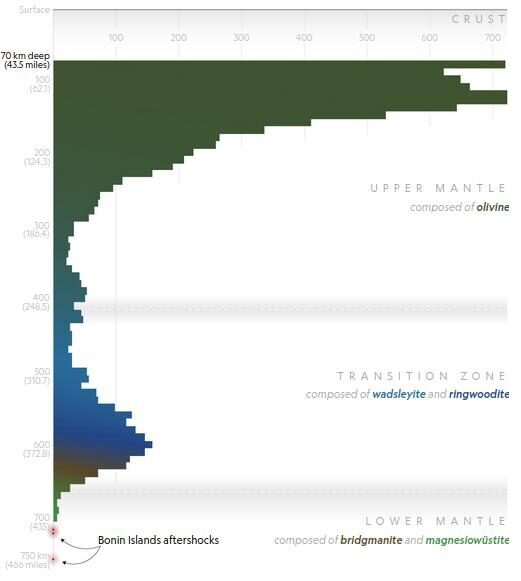
One spring evening six years ago, hundreds of miles underground, our planet began to rumble from a series of peculiar earthquakes. Most of Earth’s temblors strike within a few dozen miles of the surface, but these quakes stirred at depths where temperatures and pressures grow so intense that rocks tend to bend rather than break.
The first jolt, which struck off the coasts of Japan’s remote Bonin Islands, was recorded at magnitude 7.9 and up to 680 kilometers (423 miles) underground, making it one of the deepest quakes of its size.
Then another oddity emerged in the cascade of aftershocks that followed: a tiny temblor that, if confirmed, would be the deepest earthquake ever detected.
The ultradeep quake, described recently in the journal Geophysical Research Letters, is estimated to have struck some 751 kilometers (467 miles) beneath the surface in the layer of our planet known as the lower mantle, where scientists have long thought earthquakes unlikely, if not impossible. While there have been hints of lower mantle quakes before, researchers have struggled to pinpoint them within this layer of the Earth.
“This is by far the best evidence for an earthquake in the lower mantle,” says Douglas Wiens, a seismologist specializing in deep quakes at Washington University in St. Louis who wasn’t part of the study team.

Some scientists caution that more research is needed to confirm the quake is real and did indeed strike in the lower mantle. While the boundary sits an average of 660 kilometers (410 miles) underground, it can vary around the globe. Under Japan, the lower mantle is believed to start about 700 kilometers (435 miles) down. The team detected several aftershocks around this depth — but one particular quake sat well beyond.
While deep quakes don’t cause the same kind of devastation as their shallow counterparts, studying these events can help scientists decipher the enigmatic ways our planet shifts far beneath our feet. Seismic shudders are among the few windows into our planet’s interior workings — and each unexpected happening, like a quake in the lower mantle, could offer new views into the underworld.
Rare lower mantle quakes may be possible in particular conditions, says Heidi Houston, a geophysicist and deep quake expert at the University of Southern California who was not part of the study team. “It can’t be ruled out,” she says. “That’s one of the things that makes this interesting and exciting and important to look into.”
Rumbles from the deep
The magnitude 7.9 temblor was an oddity on its own. The great depth and large size of this quake shook the Earth near and far. Populations across all of Japan’s 47 prefectures reported feeling the earthquake, which is a first in more than 130 years of record-keeping.
In contrast, the vast majority of quakes are shallow. Of the 56,832 moderate to large earthquakes recorded between 1976 and 2020, only about 18 percent were deeper than 70 kilometers (43 miles). Even fewer, some four percent, struck below 300 kilometers (186 miles), which is the depth commonly used as a cut-off for identifying “deep earthquakes.”

For nearly a century — since English astronomer and seismologist Herbert Hall Turner spotted the first deep quake in 1922 — scientists have puzzled over how these quakes can happen at all.
Near the surface, tectonic plates’ slow-motion battles build up stress until the ground fractures and shifts, sending out the shudders of an earthquake. Deep in Earth’s underbelly, however, high pressures prevent similar jolts. “Everything is just very strongly compressed in all directions,” Houston says.
Add in the sizzling temperatures deep underground, and rocks act more like putty than solid chunks, says Magali Billen, a geodynamicist at the University of California, Davis, who was not part of the new study. She demonstrates this during a video interview using a bubble-gum pink lump of Silly Putty. As she draws it out slowly, it stretches and flows into ropey strands. But if rapidly deformed, “that’s when it breaks,” Billen says. She yanks swiftly on the rosy blob and, with a faint pop, it splits in two.
What is it that makes that happen?
To explore this question, University of Arizona seismologist Eric Kiser and his colleagues took a closer look at the large quake under the Bonin Islands, which lit up seismometers around the world, including Japan’s dense network known as the Hi-Net array.
The team sifted through Hi-Net’s trove of data in search of tremors that followed in the wake of the big quake. Such a large event would send energy ricocheting through the subsurface, which can obscure small aftershocks.
To amplify the small signals amid all the noise, the researchers used a method known as back-projection, which allows them to stack the data from multiple seismometers. Sure enough, four aftershocks rumbled between 695 and 715 kilometers deep, and another stood apart from the pack: a quake 751 kilometers underground.
Mysterious origins
All deep quakes strike near modern or ancient subduction zones, where colliding tectonic plates result in one plate grinding beneath another. Changes in the sinking slabs as they dive to extreme subterranean depths likely drive the shakes far beneath the surface.
But scientists are still unsure how the stresses build high enough to cause the deep Earth to quake. One popular idea involves the same phenomenon that splits the mantle into layers.
The upper mantle is rife with the sparkly green mineral olivine, but at greater depths, the mineral’s crystal structure is no longer stable. Starting some 410 kilometers (255 miles) down, the atoms may rearrange into the minerals wadsleyite or ringwoodite, which grow increasingly common with depth. The olivine’s transformation within the slab could create weak points in the rock where it can rapidly deform, generating a deep earthquake.
But around 660 kilometers (410 miles) down, the system abruptly changes. The dance of seismic waves around this boundary suggests the rocks below are much denser than those above — the beginning of the lower mantle.
In this layer, the earthen-hued mineral bridgmanite dominates, and the earthquake-generating transformations of olivine that can occur above no longer happen. So if a quake did strike in this layer of the planet, something else must have triggered it.
One possibility is the transformation of a different mineral within the sinking slab, such as the sepia-toned mineral enstatite. But Kiser and his colleagues also spotted another possible trigger in the movements of the slab.
The tiny aftershocks following the magnitude 7.9 quake seem to have occurred near the base of a torn slab of subducted Pacific seafloor that pierced the top of the lower mantle. The team suggests the large quake could have caused part of the mangled slab to settle slightly — “we’re talking very, very slightly,” Kiser says. That small shift might have been enough to concentrate stresses at the base of the slab as it plunged into the denser lower mantle rocks.
One way such an increase in stress could lead to the deep quake is by slightly deforming the rocks, which can generate heat and weaken them. The process could have kicked off a feedback loop, causing the rock to deform faster and faster as it grows hotter and weaker until the blocks rapidly shift in an earthquake. The building heat might have even generated melt that acted as a lubricant for the slip, Billen says.
Further analysis and modeling of the sinking slab’s structures and the positions of aftershocks from the magnitude 7.9 event could help decipher the mechanism of not only this event but other deep earthquakes. “Maybe they cannot be explained by one single mechanism,” says Haijiang Zhang, a seismologist at the University of Science and Technology of China (USTC) who was not part of the study team.
Bouncing energy
Zhang, for one, “wasn’t surprised” that an aftershock may strike within the lower mantle. In his past work, Zhang and his colleagues saw hints that the magnitude 7.9 quake near the Bonin Islands, sitting some 680 kilometers (422 miles) deep, may have also struck within this layer of the Earth.
But a lower mantle quake would overturn long-standing thinking on our planet’s inner workings — and not everyone is convinced of the new study’s claims. In some cases, the methods used to amplify the signals of a quake like this can “produce false alarms,” Yingcai Zheng, a seismologist at the University of Houston, writes via email. “The devil is in the details.”
A false alarm could occur, for example, if waves from a different earthquake bounced off Earth’s internal structures and then were picked up by the seismic array, the team notes in the study. But John Vidale, a seismologist at the University of Southern California, says that the seismic signals appear to come from a true quake at least as deep as the study authors suggest. “It looks kind of unmistakable to me,” he says.
Additional confirmation of the event could come from searching for another type of earthquake wave, known as a shear or S-wave. The new study identifies the quakes using pressure waves, or P-waves, which rapidly travel through the ground like a slinky pulled forward and back. S-waves travel slower and rock the ground side to side or up and down. If the S and P waves arrive at the expected time based on the position where the team believes this ultradeep quake occurred, Vidale says, “that kind of nails it.”
However, Vidale points out that even if the depth can be confirmed, the boundary of the lower mantle at this location is still an open question. Seismic imaging hints that as the slab sinks into the dense rocks of the lower mantle, it starts folding back and forth “like a wet noodle,” Houston says. The accumulation of cold seafloor rocks could cool the surrounding rocks, pushing the lower mantle boundary to greater depths, and making the system much more complex to interpret, she says.
Studying the Earth’s interior is never easy. “We can’t get down there,” Houston says. “We only see what the earthquake waves show us.” But as techniques to locate and study earthquakes continue to improve, scientists have a better chance at unraveling the mysterious rumbles in the deep — an effort that’s sure to unearth fresh surprises about our quivering planet.
“The data,” Billen says, “always push us to think about the Earth in a different way.”
Another record breaking seismic incident that occurred back in 2018 reveals that perhaps events such as these, and a variety of others, are on the rise and may reflect the great shift afoot on our planet. [AGU, Nat Geo]
Now subscribe to this blog to get more amazing news curated just for you right in your inbox on a daily basis (here an example of our new newsletter).
You can also follow us on Facebook and/ or Twitter. And, by the way you can also make a donation through Paypal. Thank you!
You should really subscribe to QFiles. You will get very interesting information about strange events around the world.














We are living in the end of cycle and we will witness many paradigm shifts, Earth is going to be destroyed by the humans since NWO thinks we are Virus. If we are virus then why not let COVID 21 eat us all up?
It’s Gojira!
He lives!!!
Lol, I was on the same page Michael. Beat me to it.
?